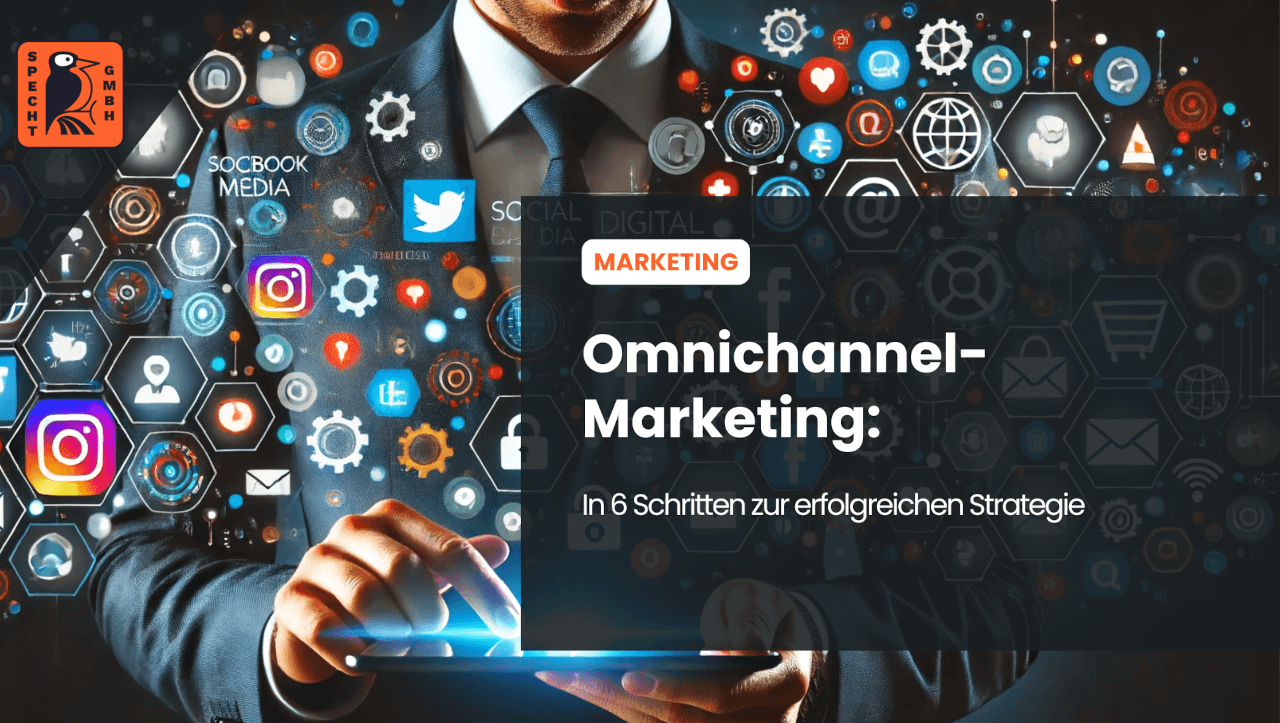With an intelligent omnichannel marketing strategy, you can create exceptional customer experiences on different channels and improve your sales in the long term.
In this article, we at Timo Specht would like to provide you with a definition of omnichannel marketing as well as effective steps towards an effective and sustainable strategy.
Omnichannel marketing: what exactly is it?
With omnichannel marketing, you create a coherent buying experience across different marketing channels.
In addition to online marketplaces, omnichannels can also include brick-and-mortar stores, apps and emails. In a way, your customers can switch back and forth between channels and benefit from a seamlessly integrated, personalized shopping experience.
Note: Omnichannel and multichannel marketing are two different terms.
Multichannel marketing is about providing as many channels as possible. Accordingly, multichannel marketing focuses on your products and services. The weakness of multichannel marketing is that the channels are operated independently of each other and do not necessarily overlap.
Unlike the multichannel strategy, omnichannels focus on the consumer and the customer experience. In concrete terms, this can be explained using an example:
After a purchase, customers receive a discount voucher from your company by email. With the omnichannel marketing strategy, on the other hand, a customer receives a personal thank you and further product recommendations after purchasing a product.
Why is omnichannel marketing so important?
Do you think that a bit of content marketing is enough for your company's success? Far from it - omnichannel marketing is more important than ever these days. After all, this marketing measure runs across many different channels and forms an important basis for acquiring new customers in the B2B and B2C sectors.
If you coordinate all channels, you guarantee an unforgettable customer experience and will be remembered as a company.
As soon as you perfect your omnichannel strategy, several channels will work hand in hand. For example, the social media channels and customer support will then work together harmoniously and be perceived by your customers as one big whole.
In summary, there are good reasons why the modern multi-channel strategy is important for companies and why you should not do without it:
Increase in sales
A smart omnichannel strategy addresses your customers at the right time via their frequently used channels. If you use three or more marketing channels, statistics show that you can generate up to 297 percent more sales.
Integrating stationary retail
With an omnichannel strategy, you can integrate a local store into your online marketing. This increases the reach of your brick-and-mortar store and attracts new customers.
Greater customer loyalty and satisfaction
With omnichannel marketing, the purchasing process is geared towards the customer's needs - not the other way around. Optimal support increases customer satisfaction beyond the shopping experience. At the same time, this measure will bind your customers even more strongly to your brand.
Positive recommendations
Satisfied customers help your company to find more buyers! This is because a positive user experience is often rewarded by customers with a good rating and a recommendation. And as we know from referral marketing, personal testimonials attract more buyers.
Harmonious brand image
If you convey a consistent image of your brand through the omnichannel approach, you will strengthen your customers' trust in your company.
Understanding the target group
Your omnichannel strategy helps you to better understand the needs of your target group. With the help of a comprehensive data analysis, you can get to know your customers' wishes even better and further optimize the customer experience after the evaluation.
Omnichannel commerce: this is what an ideal customer experience could look like in practice
In practice, the defined marketing strategy could look like this:
Your customers see products on your company's social networks that pique their interest. They then click on the ad on the Internet and go to the catalog with the product.
Consumers inform themselves online, but purchase their favorite products offline in a local store. After the purchase, customers continue to receive personalized ads with content from your online store.
Develop strategies for your omnichannel: 6 steps to success
To make your customers' purchases even more convenient across all channels, you need a well-thought-out approach and strategy.
We'll show you step by step how to develop a strategy for your various channels that attracts customers but also fits your brand.
Step 1: Define goals
First, ask yourself what goals you want to achieve with this marketing strategy. Examples of your objectives could include stronger customer loyalty, an increase in sales or greater brand recognition.
Step 2: Define target group
Successful e-commerce companies know the needs and wishes of their target group and can align their various channels accordingly.
In order to identify the customer contact points relevant to your company, you first need to know your customers. To do this, develop a buyer persona with important behavioral patterns, demographic data and preferences of your potential buyers. You can then adapt the customer journey based on the analyzed data.
Step 3: Select and link channels
Then work with your team to select the various sales channels to be used in your omnichannel marketing strategy. Compared to multichannel marketing, you should focus on the individual touchpoints here.
According to the omnichannel definition, the individual channels should flow into each other like a kind of cycle and enable a seamless customer experience. So link all of your company's relevant channels together - your store, your app, your online store and your social media channels.
Step 4: Integrate tools
Integrate the tools for your omnichannel marketing and focus on a few relevant applications. For example, CRM systems for customer relationship management, SEO tools or media analysis programs can be important for achieving your goals.
Step 5: Define key figures for measuring success
You can find out whether your omnichannel management is working successfully with the help of your defined key figures. Parameters such as the conversion rate, for example, provide you with relevant information about the success of your strategic measures.
Step 6: Adapt strategy
Maintain a certain degree of flexibility in your omnichannel strategy. Because the digital shopping world is constantly evolving. Test and refine your strategy with A/B tests and discover new ways to best address your target group.
-
Free
SEO strategy meeting
In a free SEO strategy talk, we uncover untapped potential and develop a strategy to help you become more successful on Google.

- More organic visibility
- More organic visitors to your website
- More inquiries & sales
Examples of a successful omnichannel strategy
There are various solutions for successful omnichannels. You can learn successful strategies from "big players" such as IKEA and apply them if they harmonize with your corporate philosophy and your omnichannel approach:
Click and Collect
The time-saving click and collect option is very popular with customers. Customers can place the desired products in their virtual shopping cart on the Internet, buy them online and then pick them up in-store.
In-store displays
Many stores now have in-store displays on which customers can obtain information on specific items and/or simply scan and order products.
Mobile apps
A mobile app is one of the most popular omnichannel channels.
In this app, your customers can order their items, create a wish list or call up information on the availability of individual products. If you as a company want to reach your customers across these channels, your brand should also use the app to provide personalized offers.
Communicative services
In addition to sales-promoting applications, omnichannel marketing also uses communicative sales channels as a way to get in touch with users. That's why you should always offer your customers the option of expressing questions, suggestions and requests not only via social media, but also in the traditional way via chat, telephone or email.
These communication options enhance your omnichannel approach and set you apart from other, comparable providers.
Not like this, please! Avoid typical mistakes in omnichannel marketing
To achieve good results and keep your customers happy, you should avoid typical stumbling blocks when dealing with your omnichannels:
- Ensure a mobile-friendly view on all your channels. More and more customers are using mobile devices such as cell phones for their purchases. Accordingly, your online store should also have a responsive web design.
- In contrast to multichannel marketing, omnichannels are not about having as many channels as possible. Instead, you should primarily be active where your customers are. If your shoppers like to browse in-store, then you shouldn't neglect the offline shopping experience. The same applies to your social media channels. You don't have to be active on all of them, but use the channels that are popular with your target group.
Conclusion
With well-thought-out omnichannel marketing, you can offer your customers a consistent shopping experience across multiple channels. In this way, you increase brand awareness, strengthen customer loyalty to your company and gain a better insight into the needs of your target group.
However, integrating multiple channels into your omnichannel management can be a challenge. At Timo Specht, we are happy to help you develop omnichannel solutions that make shopping even more exciting and personalized for your customers.
- Do you know my SEO newsletter?
Register now and receive regular tips from the experts.

